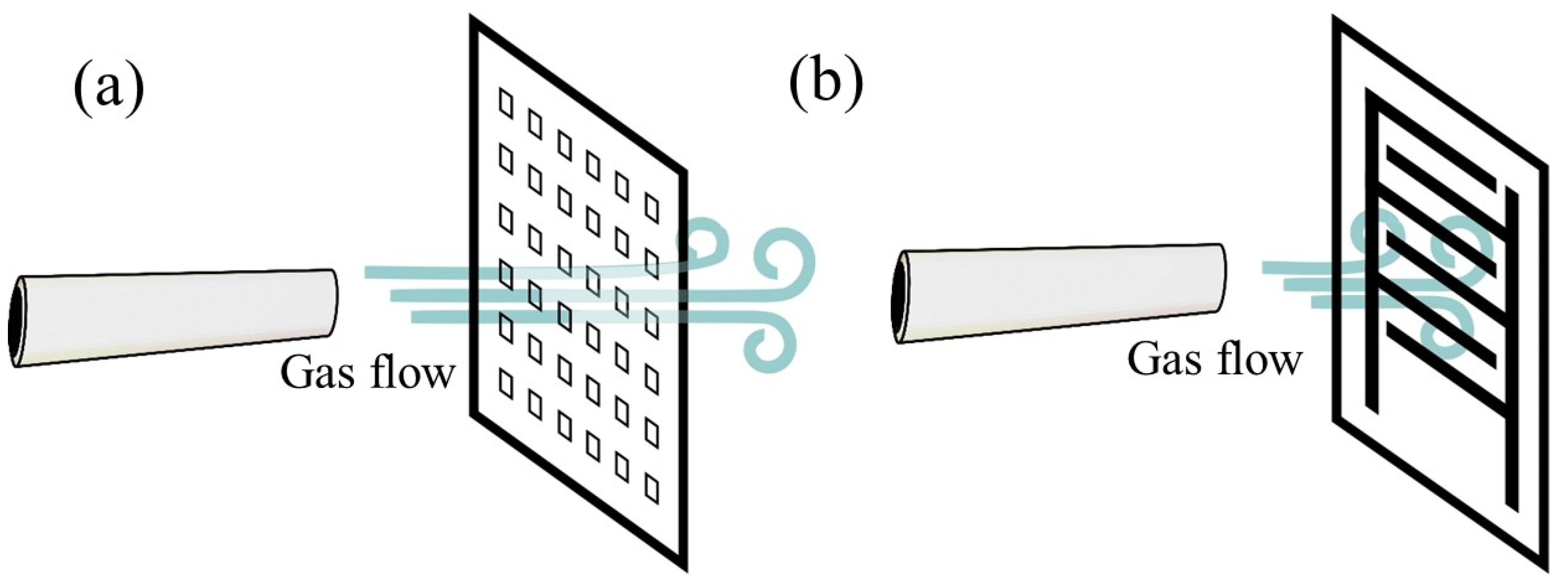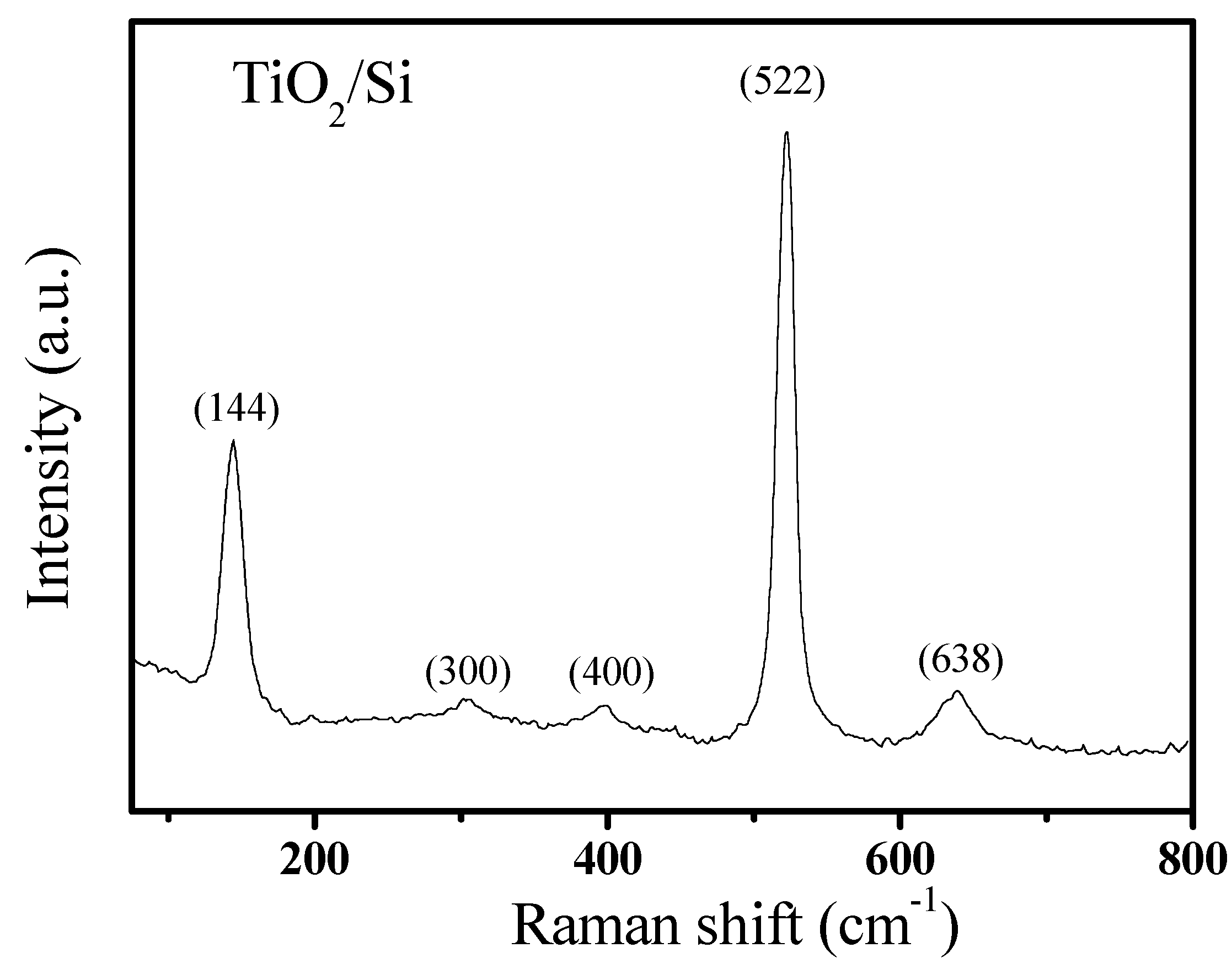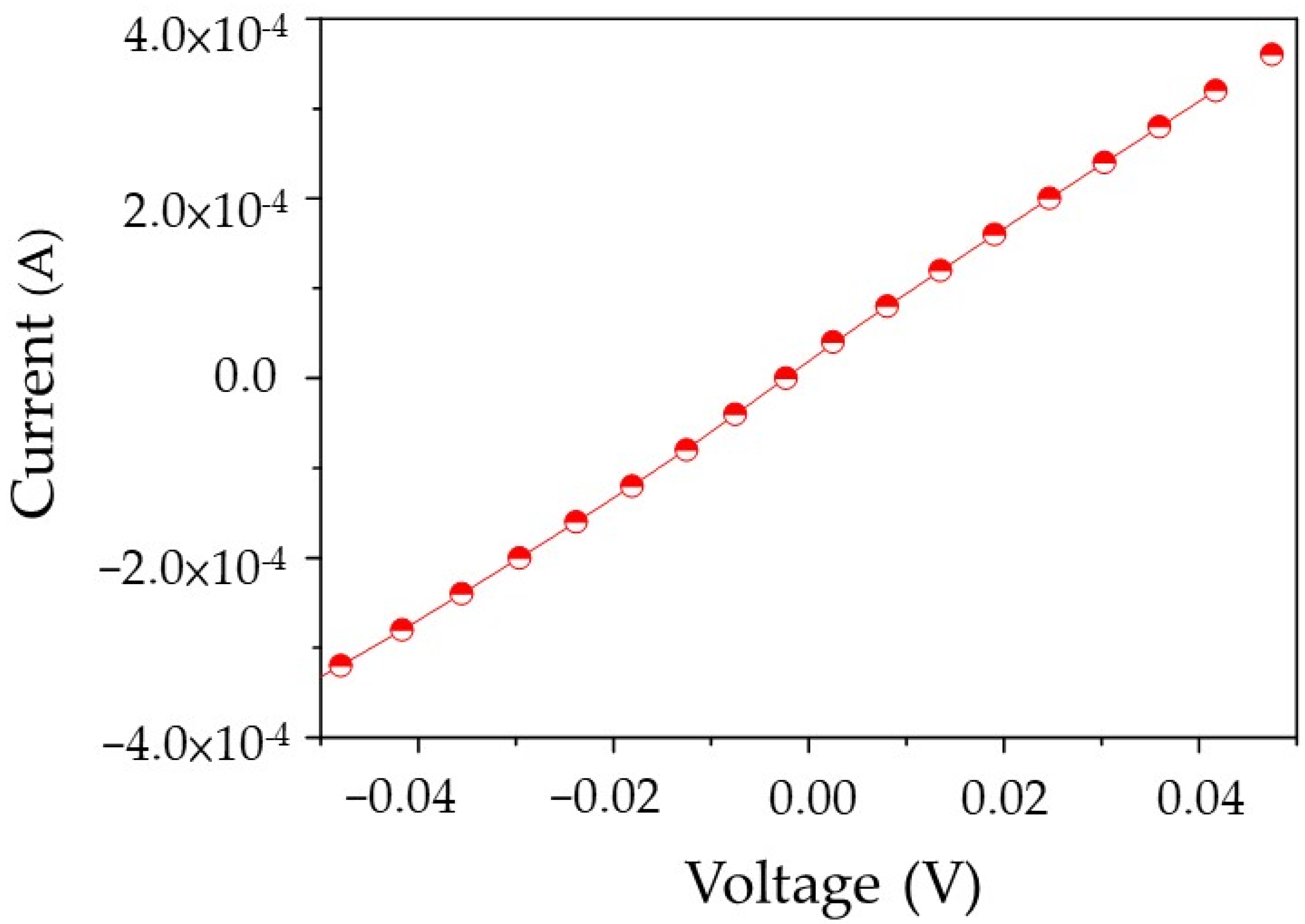A TSV-Structured Room Temperature p-Type TiO2 Nitric Oxide Gas Sensor
Abstract
1. Introduction
2. Materials and Methods
3. Results
4. Conclusions
Author Contributions
Funding
Institutional Review Board Statement
Informed Consent Statement
Data Availability Statement
Acknowledgments
Conflicts of Interest
References
- Afzal, A.; Cioffi, N.; Sabbatini, L.; Torsi, L. NOx sensors based on semiconducting metal oxide nanostructures. Progress and perspectives. Sens. Actuator B Chem. 2012, 171, 25–42. [Google Scholar] [CrossRef]
- Akamatsu, T.; Itoh, T.; Izu, N.; Shin, W. NO and NO2 sensing properties of WO3 and Co3O4 based gas sensors. Sensors 2013, 13, 12467–12481. [Google Scholar] [CrossRef] [PubMed]
- Cui, L.; Han, F.; Dai, W.; Murray, E.P. Influence of microstructure on the sensing behavior of NOx exhaust gas sensors. J. Electrochem. Soc. 2014, 161, B34–B38. [Google Scholar] [CrossRef]
- Qin, Y.; Shen, W.; Li, X.; Hu, M. Effect of annealing on microstructure and NO2 sensing properties of tungsten oxide nanowires synthesized by solvothermal method. Sens. Actuators B Chem. 2011, 155, 646–652. [Google Scholar] [CrossRef]
- Tseliou, E.; Bessa, V.; Hillas, G.; Delimpoura, V.; Papadaki, G.; Roussos, C.; Papiris, S.; Bakakos, P.; Loukides, S. Exhaled nitric oxide and exhaled breath condensate pH in severe refractory asthma. CHEST 2010, 138, 107–113. [Google Scholar] [CrossRef] [PubMed]
- Barnes, P.J.; Liew, F.Y. Nitric oxide and asthmatic inflammation. Immunol. Today 1995, 16, 128–130. [Google Scholar] [CrossRef]
- Choi, B.S.; Kim, K.W.; Lee, Y.J.; Baek, J.; Park, H.B.; Kim, Y.H.; Sohn, M.H.; Kim, K.E. Exhaled Nitric Oxide is Associated with Allergic Inflammation in Children. J. Korean Med. Sci. 2011, 10, 1265–1269. [Google Scholar] [CrossRef]
- Smith, A.D.; Cowan, J.O.; Brassett, K.P.; Herbison, G.P.; Taylor, R.D. Use of Exhaled Nitric Oxide Measurements to Guide Treatment in Chronic Asthma. N. Engl. J. Med. 2005, 352, 2163–2173. [Google Scholar] [CrossRef] [PubMed]
- Pour, G.B.; Aval, L.F.; Esmaili, P. Performance of gas nanosensor in 1–4 percent hydrogen concentration. Sens. Rev. 2019, 39, 622–628. [Google Scholar] [CrossRef]
- Pour, G.B.; Aval, L.F. Influence of oxide film surface morphology and thickness on the properties of gas sensitive nanostructure sensor. Indian J. Pure Appl. Phys. 2019, 57, 743–749. [Google Scholar]
- Ji, H.; Qin, W.; Yuan, Z.; Meng, F. Qualitative and quantitative recognition method of drug-producing chemicals based on SnO2 gas sensor with dynamic measurement and PCA weak separation. Sens. Actuators B Chem. 2021, 348, 130698. [Google Scholar] [CrossRef]
- González-Garnica, M.; Galdámez-Martínez, A.; Malagón, F.; Ramos, C.D.; Santana, G.; Abolhassani, R.; Panda, P.K.; Kaushik, A.; Mishra, Y.K.; Karthik, T.V.K.; et al. One dimensional Au-ZnO hybrid nanostructures based CO2 detection: Growth mechanism and role of the seed layer on sensing performance. Sens. Actuators B Chem. 2021, 337, 129765. [Google Scholar] [CrossRef]
- Hou, J.L.; Hsueh, T.J. Temperature-Dependent n-Type and p-Type Sensing Behaviors of CuO Nanosheets/MEMS to NO2 Gas. ACS Appl. Electron. Mater. 2021, 3, 4817–4823. [Google Scholar] [CrossRef]
- Hsueh, T.J.; Wu, S.S. Highly sensitive Co3O4 nanoparticles/MEMS NO2 gas sensor with the adsorption of the Au nanoparticles. Sens. Actuators B Chem. 2021, 329, 129201–129209. [Google Scholar] [CrossRef]
- Chang, T.J.; Hsueh, T.J. A NO2 gas sensor with a TiO2 nanoparticles/ZnO/MEMS-structure that is produced using ultrasonic wave grinding technology. J. Electrochem. Soc. 2020, 167, 027521–027525. [Google Scholar] [CrossRef]
- Wang, S.; Pan, L.; Song, J.J.; Mi, W.; Zou, J.J.; Wang, L.; Zhang, X. Titanium-Defected Undoped Anatase TiO2 with p-Type Conductivity, Room-Temperature Ferromagnetism, and Remarkable Photocatalytic Performance. J. Am. Chem. Soc. 2015, 137, 2975–2983. [Google Scholar] [CrossRef]
- Fu, A.; Chen, X.; Tong, L.; Wang, D.; Liu, L.; Liu, L.; Ye, J. Remarkable Visible-Light Photocatalytic Activity Enhancement over Au/p-type TiO2 Promoted by Efficient Interfacial Charge Transfer. ACS Appl. Mater. Interfaces 2019, 11, 24154–24163. [Google Scholar] [CrossRef] [PubMed]
- Tang, H.; Prasad, K.; Sanjinés, R.; Lévy, F. TiO2 anatase thin films as gas sensors. Sens. Actuators B Chem. 1995, 26, 71–75. [Google Scholar] [CrossRef]
- Hsu, C.L.; Tsai, J.Y.; Hsueh, T.J. Ethanol gas and humidity sensors of CuO/Cu2O composite nanowires based on a Cu through-silicon via approach. Sens. Actuators B Chem. 2016, 224, 95–102. [Google Scholar] [CrossRef]
- Lu, C.L.; Chang, S.J.; Chen, W.S.; Hsueh, T.J. Through-Silicon via Submount for Flip-Chip LEDs. ECS J. Solid State Sci. Technol. 2017, 6, R159–R162. [Google Scholar] [CrossRef][Green Version]
- Lu, C.L.; Chang, S.J.; Chen, W.S.; Hsueh, T.J. 3D RGB Light Emitting Diodes Prepared by Through Silicon Via Technology. ECS J. Solid State Sci. Technol. 2018, 7, R156–R159. [Google Scholar] [CrossRef]
- Hsu, C.L.; Tsai, J.-Y.; Hsueh, T.J. Novel field emission structure of CuO/Cu2O composite nanowires based on copper through silicon via technology. RSC Adv. 2015, 5, 33762–33766. [Google Scholar] [CrossRef]
- Lam, K.T.; Chen, Y.H.; Hsueh, T.J.; Chang, S.J. A 3-D ZnO-Nanowire Smart Photo Sensor Prepared with Through Silicon via Technology. IEEE Trans. Electron Devices 2016, 63, 3562–3566. [Google Scholar] [CrossRef]
- Pan, C.T.; Chen, Y.C.; Wang, S.Y.; Cheng, Y.T.; Yen, C.K.; Lin, Y.L.; Shih, W.C. TSV by 355 UV laser for 4G component packaging with micro-electroforming. Microelectron. Reliab. 2017, 78, 331–338. [Google Scholar] [CrossRef]
- Kamto, A.; Divan, R.; Sumant, A.V.; Burkett, S.L. Cryogenic inductively coupled plasma etching for fabrication of taperedthrough-silicon vias. J. Vac. Sci. Technol. A 2010, 28, 719–725. [Google Scholar] [CrossRef]
- Ranganathan, N.; Lee, D.Y.; Youhe, L.; Lo, G.Q.; Prasad, K.; Pey, K.L. Influence of Bosch Etch Process on Electrical Isolation of TSV Structures. IEEE Trans. Compon. Packag. Manuf. Technol. 2011, 1, 1497–1507. [Google Scholar] [CrossRef]
- Mauer, L.B.; Taddei, J.; Youssef, R.; Lu, Y.; Collins, S.; McLaughlin, K.; Allen, C. Wet Silicon Etch Process for TSV Reveal. In Proceedings of the 2014 IEEE 64th Electronic Components and Technology Conference, Orlando, FL, USA, 27–30 May 2014; pp. 878–882. [Google Scholar]
- Knaut, M.; Junige, M.; Neumann, V.; Wojcik, H.; Henke, T.; Hossbach, C.; Hiess, A.; Albert, M.; Bartha, J.W. Atomic layer deposition for high aspect ratio through silicon vias. Microelectron. Eng. 2013, 107, 80–83. [Google Scholar] [CrossRef]
- Wang, Z.; Jiang, F.; Yu, D.Q.; Zhang, W.Q. Si Etching for TSV Formation. ECS Trans. 2014, 60, 407–412. [Google Scholar] [CrossRef]
- Hsueh, T.J.; Lee, S.H. A La2O3 Nanoparticle SO2 Gas Sensor that Uses a ZnO Thin Film and Au Adsorption. J. Electrochem. Soc. 2021, 168, 077507–077515. [Google Scholar] [CrossRef]
- Das, M.; Sarkar, D. Morphological and optical properties of n-type porous silicon: Effect of etching current density. Bull. Mater. Sci. 2016, 39, 1671–1676. [Google Scholar] [CrossRef]
- Tian, F.; Zhang, Y.; Zhang, J.; Pan, C. Raman Spectroscopy: A New Approach to Measure the Percentage of Anatase TiO2 Exposed (001) Facets. J. Phys. Chem. C 2012, 116, 7515–7519. [Google Scholar] [CrossRef]
- Wang, M.; Zhu, Y.; Meng, D.; Wang, K.; Wang, C. A novel room temperature ethanol gas sensor based on 3D hierarchical flower-like TiO2 microstructures. Mater. Lett. 2020, 277, 128372. [Google Scholar] [CrossRef]
- Chethana, D.M.; Thanuja, T.C.; Mahesh, H.M.; Kiruba, M.S.; Jose, A.S.; Barshilia, H.C.; Manjanna, J. Synthesis, structural, magnetic and NO2 gas sensing property of CuO nanoparticles. Ceram. Int. 2021, 47, 10381–10387. [Google Scholar] [CrossRef]
- Li, D.; Tang, Y.; Ao, D.; Xiang, X.; Wang, S.; Zu, X. Ultra-highly sensitive and selective H2S gas sensor based on CuO with sub-ppb detection limit. Int. J. Hydrogen Energy 2019, 44, 3985–3992. [Google Scholar] [CrossRef]
- Lin, C.Y.; Chen, J.G.; Feng, W.Y.; Lin, C.W.; Huang, J.W.J.; Tunney, J.; Ho, K.C. Using a TiO2/ZnO double-layer film for improving the sensing performance of ZnO based NO gas sensor. Sens. Actuators B Chem. 2011, 157, 361–367. [Google Scholar] [CrossRef]
- Kuchi, C.; Naresh, B.; Reddy, P.S. In Situ TiO2-rGO Nanocomposite for Low Concentration NO Gas Sensor. ECS J. Solid State Sci. Technol. 2021, 10, 037008. [Google Scholar] [CrossRef]
- Murali, G.; Reddeppa, M.; Reddy, C.S.; Park, S.; Chandrakalavathi, T.; Kim, M.D.; In, I. Enhancing the Charge Carrier Separation and Transport via Nitrogen-Doped Graphene Quantum Dot-TiO2 Nanoplate Hybrid Structure for an Efficient NO Gas Sensor. ACS Appl. Mater. Interfaces 2020, 12, 13428–13436. [Google Scholar] [CrossRef]
- Khasim, S.; Pasha, A.; Hatem-Al-Aoh; Badi, N.; Imran, M.; Al-Ghamdi, S.A. Development of high-performance flexible and stretchable sensor based on secondary doped PEDOT-PSS:TiO2 nanocomposite for room-temperature detection of nitric oxide. J. Mater. Sci. Mater. Electron. 2021, 32, 7491–7508. [Google Scholar] [CrossRef]
- Hong, L.Y.; Lin, H.N. NO gas sensing at room temperature using single titanium oxide nanodot sensors created by atomic force microscopy nanolithography. Beilstein J. Nanotechnol. 2016, 7, 1044–1051. [Google Scholar] [CrossRef]
- Luo, P.; Xie, M.; Luo, J.; Kan, H.; Wei, Q. Nitric oxide sensors using nanospiral ZnO thin film deposited by GLAD for application to exhaled human breath. RSC Adv. 2020, 10, 14877–14884. [Google Scholar] [CrossRef]









| Materials | Structure | Concentration (ppm) | Optimum Operation Temperature (°C) | Response Time (s.) | Recovery Time (s.) | Reference |
|---|---|---|---|---|---|---|
| TiO2NP/ZnO film | Planar | 10 | 360 | 492 | 336 | [36] |
| TiO2-rGO Nanocomposite | Planar | 2.75 | RT | 440 | 881 | [37] |
| TiO2@NGQDs | Planar | 100 | RT | 235 | 285 | [38] |
| PEDOT–PSS:DEG-TiO2 | Planar | 1 | RT | 416 | 33 | [39] |
| TiO2 nanodot | Planar | 10 | RT | 91 | 184 | [40] |
| TiO2 Film | TSV | 4 | RT | 109 | 144 | This work |
Publisher’s Note: MDPI stays neutral with regard to jurisdictional claims in published maps and institutional affiliations. |
© 2022 by the authors. Licensee MDPI, Basel, Switzerland. This article is an open access article distributed under the terms and conditions of the Creative Commons Attribution (CC BY) license (https://creativecommons.org/licenses/by/4.0/).
Share and Cite
Yeh, Y.-M.; Chang, S.-J.; Wang, P.-H.; Hsueh, T.-J. A TSV-Structured Room Temperature p-Type TiO2 Nitric Oxide Gas Sensor. Appl. Sci. 2022, 12, 9946. https://doi.org/10.3390/app12199946
Yeh Y-M, Chang S-J, Wang P-H, Hsueh T-J. A TSV-Structured Room Temperature p-Type TiO2 Nitric Oxide Gas Sensor. Applied Sciences. 2022; 12(19):9946. https://doi.org/10.3390/app12199946
Chicago/Turabian StyleYeh, Yu-Ming, Shoou-Jinn Chang, Pin-Hsiang Wang, and Ting-Jen Hsueh. 2022. "A TSV-Structured Room Temperature p-Type TiO2 Nitric Oxide Gas Sensor" Applied Sciences 12, no. 19: 9946. https://doi.org/10.3390/app12199946
APA StyleYeh, Y.-M., Chang, S.-J., Wang, P.-H., & Hsueh, T.-J. (2022). A TSV-Structured Room Temperature p-Type TiO2 Nitric Oxide Gas Sensor. Applied Sciences, 12(19), 9946. https://doi.org/10.3390/app12199946






